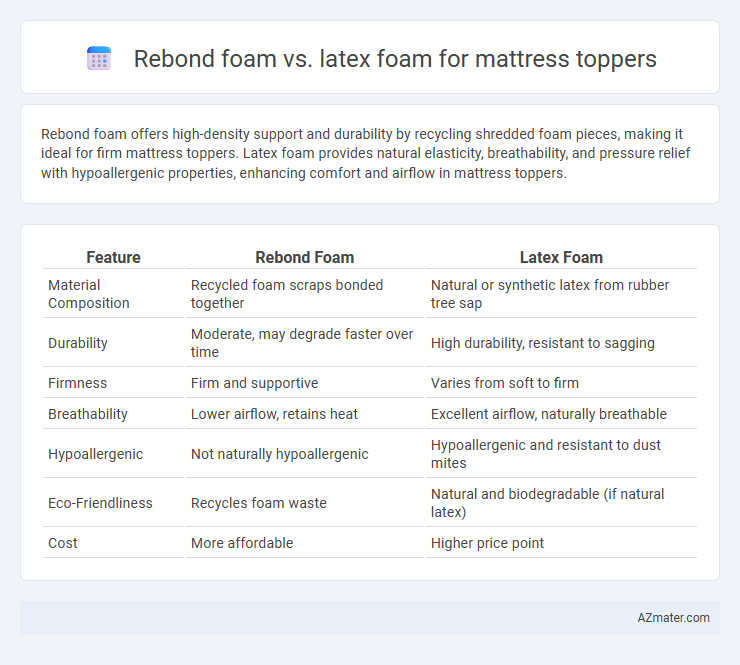Rebond foam offers high-density support and durability by recycling shredded foam pieces, making it ideal for firm mattress toppers. Latex foam provides natural elasticity, breathability, and pressure relief with hypoallergenic properties, enhancing comfort and airflow in mattress toppers.
Table of Comparison
| Feature | Rebond Foam | Latex Foam |
|---|---|---|
| Material Composition | Recycled foam scraps bonded together | Natural or synthetic latex from rubber tree sap |
| Durability | Moderate, may degrade faster over time | High durability, resistant to sagging |
| Firmness | Firm and supportive | Varies from soft to firm |
| Breathability | Lower airflow, retains heat | Excellent airflow, naturally breathable |
| Hypoallergenic | Not naturally hypoallergenic | Hypoallergenic and resistant to dust mites |
| Eco-Friendliness | Recycles foam waste | Natural and biodegradable (if natural latex) |
| Cost | More affordable | Higher price point |
Introduction to Mattress Topper Materials
Rebond foam, made from shredded and compressed foam scraps, offers firm support and durability ideal for those seeking pressure relief and motion isolation. Latex foam, derived from natural or synthetic rubber, provides a resilient, breathable, and hypoallergenic surface with excellent contouring and bounce. Choosing between rebond and latex foam mattress toppers depends on preferences for firmness, cooling properties, and responsiveness to body movement.
What is Rebond Foam?
Rebond foam is a highly durable mattress topper material made by shredding and compressing scrap polyurethane foam pieces into dense layers, providing excellent support and pressure relief. Unlike latex foam, which is derived from natural or synthetic rubber, rebond foam offers firm cushioning suitable for heavier body types and helps enhance mattress longevity. Its dense structure also improves resistance to sagging and deformation, making it a cost-effective choice for mattress toppers.
What is Latex Foam?
Latex foam is a natural material derived from the sap of rubber trees, known for its resilience, breathability, and hypoallergenic properties, making it ideal for mattress toppers. Unlike rebond foam, which is made from shredded foam scraps bonded together, latex foam offers superior elasticity and pressure relief, conforming to body contours for enhanced comfort. Its open-cell structure promotes airflow, helping regulate temperature and reduce moisture buildup during sleep.
Rebond Foam vs Latex Foam: Key Differences
Rebond foam, made from recycled foam scraps bonded together, offers high density and firm support ideal for budget-friendly mattress toppers, while latex foam provides natural breathability, resilience, and pressure relief with hypoallergenic properties. Rebond foam tends to retain heat and has less elasticity compared to the buoyant and cooler feel of latex foam, which adapts better to body contours for enhanced comfort. Durability favors latex foam due to its resistance to sagging and dust mites, making it a premium choice over the more affordable, but less durable, rebond foam.
Comfort and Support Comparison
Rebond foam provides firm support and durability by compressing shredded foam pieces together, making it ideal for individuals seeking robust spinal alignment and pressure relief. Latex foam offers superior contouring and breathability with its natural elasticity, ensuring enhanced comfort through adaptive cushioning and temperature regulation. While rebond foam excels in long-lasting support for heavier users, latex foam delivers a softer, more responsive feel suited for those prioritizing comfort and hypoallergenic properties.
Durability and Longevity
Rebond foam exhibits high durability due to its dense, compressed structure made from recycled foam scraps, which offers long-lasting support and resilience against wear and tear. Latex foam, derived from natural or synthetic latex, provides superior longevity with excellent resistance to sagging, dust mites, and mold, maintaining its shape and comfort for many years. Both materials excel in durability, but latex foam generally surpasses rebond foam in long-term performance, especially in maintaining consistent support and hygiene.
Breathability and Temperature Regulation
Rebond foam offers moderate breathability but tends to retain more heat compared to latex foam, making it less ideal for temperature regulation. Latex foam exhibits superior airflow and natural moisture-wicking properties, promoting cooler sleep and enhanced breathability. The open-cell structure of latex foam ensures efficient heat dissipation, contributing to a more comfortable sleeping environment.
Allergy and Environmental Impact
Rebond foam is made from recycled polyurethane foam scraps, making it a budget-friendly and eco-conscious option but it can off-gas volatile organic compounds (VOCs) that may trigger allergies in sensitive individuals. Latex foam, derived from natural rubber tree sap, offers superior hypoallergenic properties and resists dust mites, mold, and bacteria, enhancing indoor air quality. Environmentally, natural latex is biodegradable and sustainably harvested, whereas rebond foam relies on synthetic materials that contribute more heavily to landfill waste.
Price Comparison
Rebond foam mattress toppers are generally more affordable than latex foam toppers, making them a popular choice for budget-conscious buyers. Latex foam, especially natural latex, commands a higher price due to its durability, natural materials, and hypoallergenic properties. While rebond foam offers cost-effective comfort support, latex foam provides longer-term investment with superior resilience and breathability.
Which Mattress Topper is Right for You?
Rebond foam mattress toppers offer firm support and durability, making them ideal for individuals needing pressure relief and spinal alignment. Latex foam mattress toppers provide excellent elasticity, breathability, and hypoallergenic properties, suitable for those seeking comfort and natural temperature regulation. Choosing the right mattress topper depends on your preferred firmness level, sensory comfort, and any allergy considerations.

Infographic: Rebond foam vs Latex foam for Mattress topper
 azmater.com
azmater.com